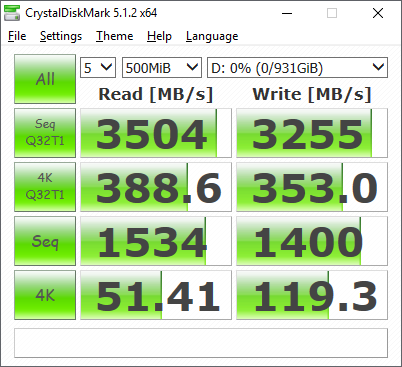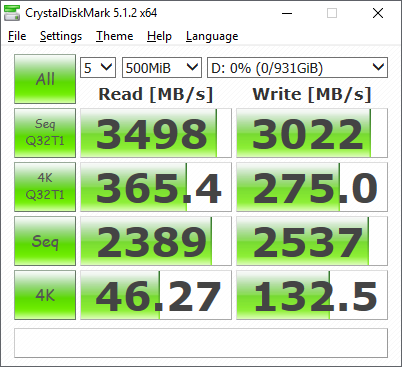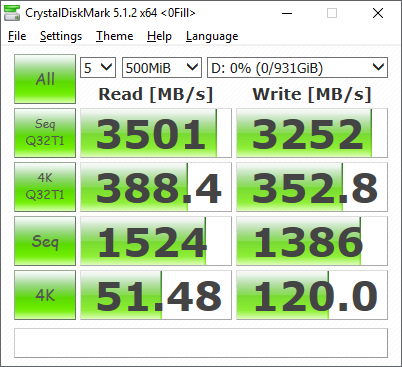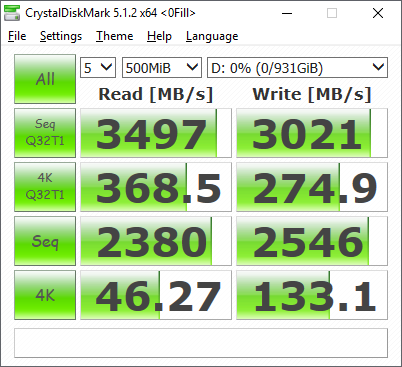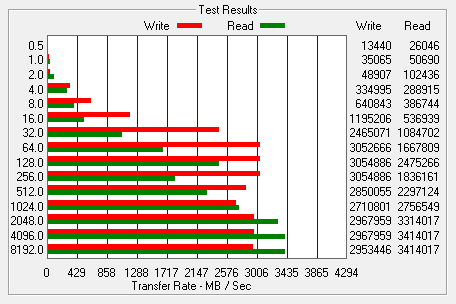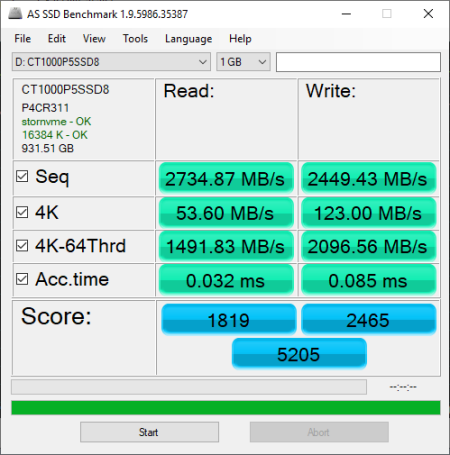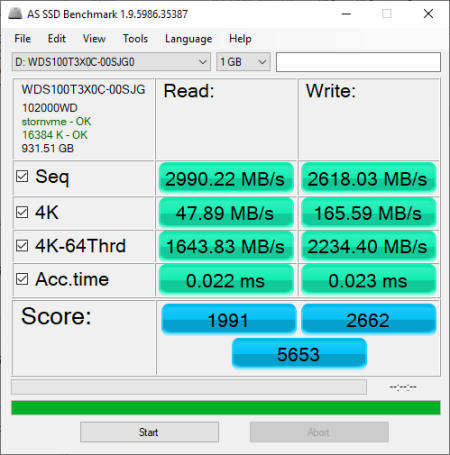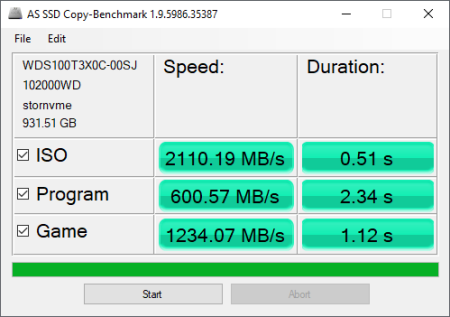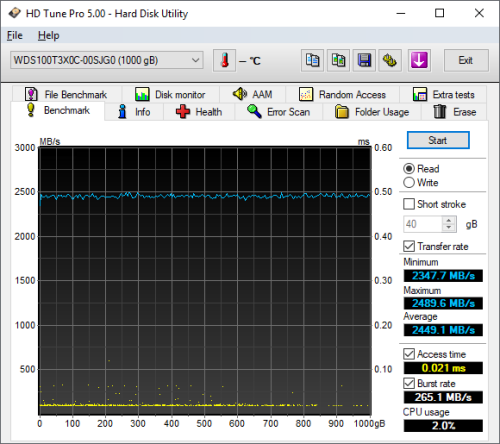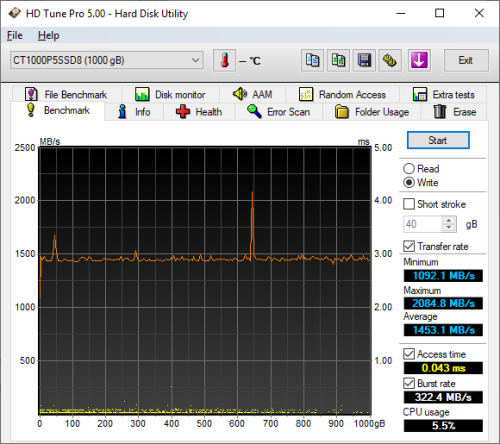

Model: Crucial P5 1TB PCIe M.2 Solid State Drive
Manufacturer: Crucial
Provided By: Crucial
Crucial is a global brand of Micron Technology, Inc., one of the largest memory and flash storage manufacturers in the world. The company's product lineup includes award-winning solid state drives (SSDs) and computer memory upgrades (DRAM) for more than 50,000 systems. These products have been qualified and approved by major original equipment manufacturers and every single module has been rigorously tested at the component and module level. Each SSD also undergoes over a thousand hours of prerelease validation testing and hundreds of qualification tests to ensure optimal reliability and performance.
Earlier this year, Crucial introduced two new PCIe SSDs. Along with the affordable, entry-level P2, the company launched the P5, its fastest and most innovative SSD to date. Engineered for serious gamers and creative professionals, this M.2 form factor drive is powered by Micron's own DM01B2 controller and is available with up to 2TB of their 3D TLC NAND flash. The P5 also includes advanced features like dynamic write acceleration, error correction, full hardware-based encryption and adaptive thermal protection to keep your data safe while enhancing system reliability. To top it all off, the drive is equipped with an ultra-fast PCIe Gen3 x4 NVMe 1.3 interface and is capable of 3,400 MB/s read and 3,000 MB/s write speeds.
The P5 is available in 250GB, 500GB, 1TB and 2TB capacities. For this review, Crucial sent us the 1TB version of the drive which is capable of delivering up to 3,400 MB/s sequential read and 3,000 MB/s sequential write speeds as well as up to 390,000 random read and 500,000 random write IOPS.
| Crucial P5 1TB PCIe M.2 Solid State Drive | |||||||||||||||||||||||||||
General Specifications
Performance
Reliability
Environmental
Other Features
|
Needless to say, this is only a taste of what the P5 has to offer. To give you an idea of what to expect, we'll take a closer look at Crucial's new PCIe SSD and then see how well it performs. Does the P5 have what it takes? Can it deliver the performance and features that we've come to expect from Crucial? Keep reading as we find out.
The P5 comes in a small, blue and white box. While there aren't a lot of technical details, the packaging advertises some of the drive's key features including its 1TB capacity, support for NVMe, and 5 year warranty. The back of the box also has a small window that lets you see the drive and view the QR code on it. Inside, you'll find the P5 as well as a small guide with information on where you can get additional help and download the migration and cloning software.

Physical Features:
The P5 uses the 2280 form factor for M.2 (NGFF) SSDs. It measures 22 x 80 x 2.25 mm and tips the scales at less than 8g. The drive also has an "M key" edge connector which provides PCIe SSDs with up to 4x lanes of bandwidth.
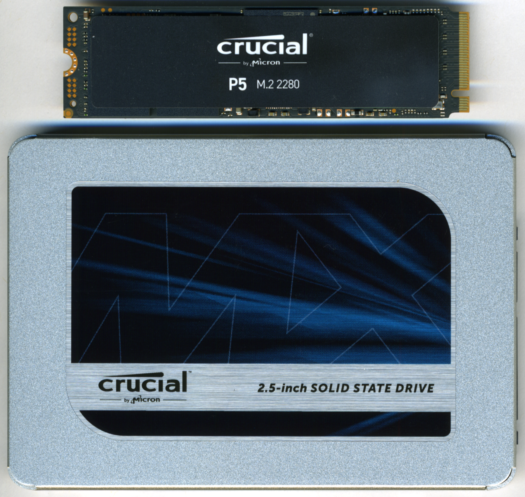
The P5 is one of the first drives to use Micron's new DM01B2 controller. Not much is known about this controller aside from that it was designed in house, has eight channels and supports hardware-based encryption.


For the 1TB version of the P5, Crucial opted to use Micron's 96-layer 3D TLC NAND flash. If you'd remove the sticker, you'd see that there are two 512GB NAND flash packages on the top of the PCB. The drive also has a single 1GB Micron LPDDR4 DRAM chip that is used for caching.
The test system used in this review is equipped with an Intel Core i7-6700K CPU, GIGABYTE GA-Z170X-UD3 motherboard, 32GB (16GB x 2) of Crucial Ballistix Sport LT DDR4 memory, Samsung 960 PRO 512GB SSD and a GIGABYTE GeForce GTX 1060 WINDFORCE OC 6G graphics card. For the operating system, I installed a fresh copy of Windows 10 Enterprise.
To test the performance of Crucial's P5 SSD, I ran a series of benchmarks using CrystalDiskMark, HD Tach RW, ATTO Disk Benchmark, AS SSD, HD Tune Pro, Anvil's Storage Utilities, Iometer and PCMark 8. For comparison, I've also included test results from the ADATA SWORDFISH, ADATA FALCON, Lexar NM610, Silicon Power P34A60, Patriot P300, Plextor M9PG Plus, Plextor M9PY Plus, ADATA XPG SX6000 Pro, Western Digital WD Black SN750, Samsung 970 EVO Plus, ADATA XPG SX8200 Pro, Crucial P1, ADATA XPG SX8200, Western Digital WD Black NVMe, Samsung 970 EVO, Samsung 970 PRO, Plextor M9Pe, Plextor M8Se, Patriot Hellfire, ADATA XPG SX8000, Samsung 960 PRO, Toshiba OCZ RD400, Samsung 950 PRO, Samsung 870 QVO, Silicon Power P60, SK hynix Gold S31, ADATA Ultimate SU750, Samsung 860 QVO, Samsung 860 PRO, Crucial MX500, Plextor M8V, Samsung T5, Crucial BX300 and ADATA Ultimate SU900.
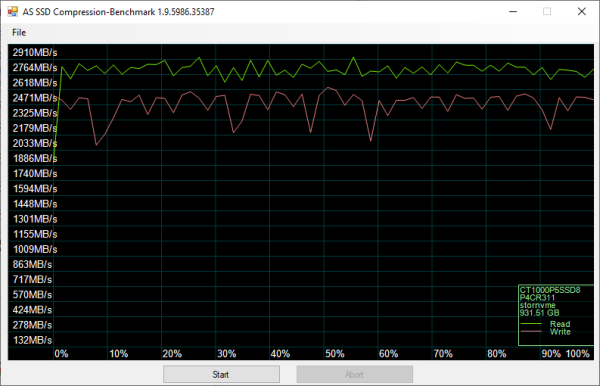
As I mentioned earlier, the P5 uses Micron's DM01B2 controller chip. Looking at the screenshot above, you can see that it performs equally well with both incompressible (0%) and compressible (100%) data.
CrystalDiskMark 5.1.2:
First, I ran a few quick tests using CrystalDiskMark. This benchmark tool measures the performance of a storage device by testing its sequential read and write speeds as well as its random read and write speeds using blocks 512K and 4K in size.
According to Crucial, the 1TB version of the P5 is capable of reading at 3,500 MB/s and writing at 3,000 MB/s. Looking at the screenshot above, you can see that the drive had no problems reaching these speeds in CrystalDiskMark's sequential read and write tests.
The P5 performed equally well when using highly compressible 0x00 (0 Fill) data. This time around, the drive was able to read at 3,501 MB/s and write at 3,252 MB/s.
HD Tach RW 3.0.4.0:
Next, I used HD Tach to test the Crucial P5's read, write and burst speeds as well as its seek times and CPU usage.
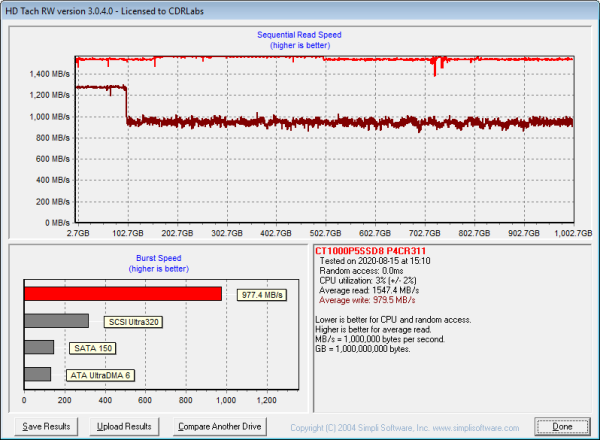
Looking at the screenshot above, you can see that the P5 had average read and write speeds of 1,547.4 MB/s and 979.5 MB/s respectively, as well as a burst speed of 977.4 MB/s. The screenshot also shows that, like most other TLC-based SSDs, the P5 uses some sort of SLC caching. The drive starts writing at about 1,275 MB/s and then drops to about 950 MB/s when the write operation exceeds the size of the cache.
ATTO Disk Benchmark 2.46:
I also used ATTO Disk Benchmark to test the Crucial P5's sequential read and write speeds. The tests are run using blocks ranging in size from 0.5KB to 8192KB and the total length set to 256MB.
When tested with ATTO, the Crucial P5's read speeds topped out at about 3,414 MB/s and its write speeds at 3,054 MB/s.
AS SSD:
AS SSD is a relatively new benchmark designed specifically for solid state drives. The application contains five synthetic tests used to determine the sequential and random read and write performance of a drive.
AS SSD also includes a copy benchmark. This test copies an ISO (two large files), program (many small files) and game (small and large files), returning the speed and duration of each.
HD Tune Pro 5.00:
Next, I ran a series of tests using HD Tune Pro. This hard disk utility measures a drive's performance by testing its sequential read and write speeds as well as its access time, burst rate and CPU usage. For this review, I'm also going to use it to benchmark the Crucial P5's random read and write speeds, random access times and the number of operations per second.
The P5 didn't perform as well as expected when benchmarked with HD Tune. The drive had average read and write speeds of 1599.0 MB/s and 1453.1 MB/s, respectively.
When reading 4KB blocks, the P5 reached 30,931 IOPS and had an average speed of 120.824 MB/s. The drive was a bit faster when writing, reaching 35,472 IOPS with an average speed of 138.564 MB/s.
Anvil's Storage Utilities:
Anvil's Storage Utilities is another benchmark designed with SSDs in mind. The standard storage benchmark measures a drive's performance by testing its transfer speeds, access times and IOPS.
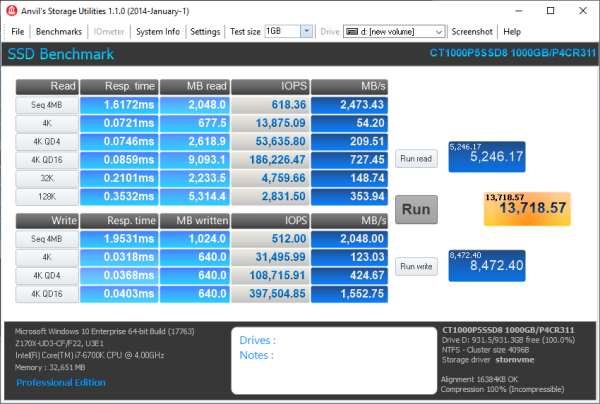
Iometer:
Lastly, I ran a series of tests using Iometer. This tool can be configured to benchmark a number of things. In this case, I used it to measure the P5's read and write speeds and the number of operations per second. The tests were run using random bytes and a queue depth of 3.
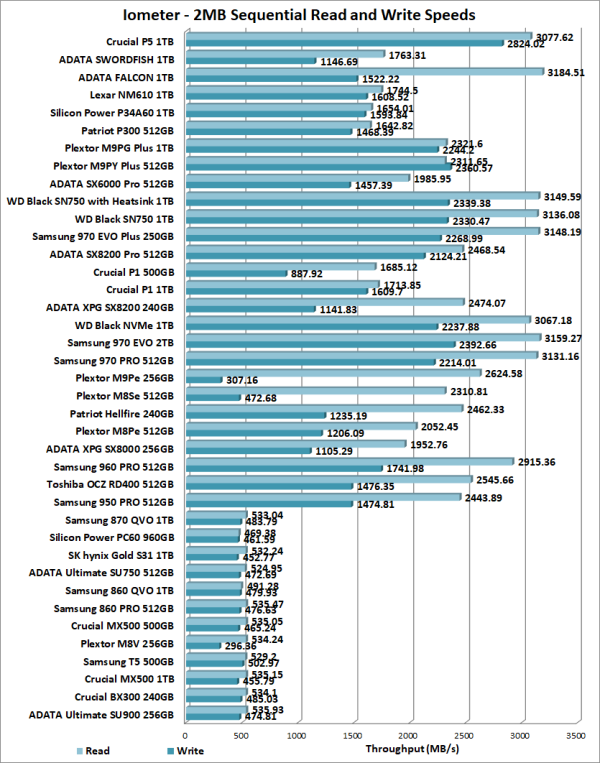
The P5's performance was very similar to what we saw in our other tests. The drive was able to read at 3077.62 MB/s and write at 2824.02 MB/s.
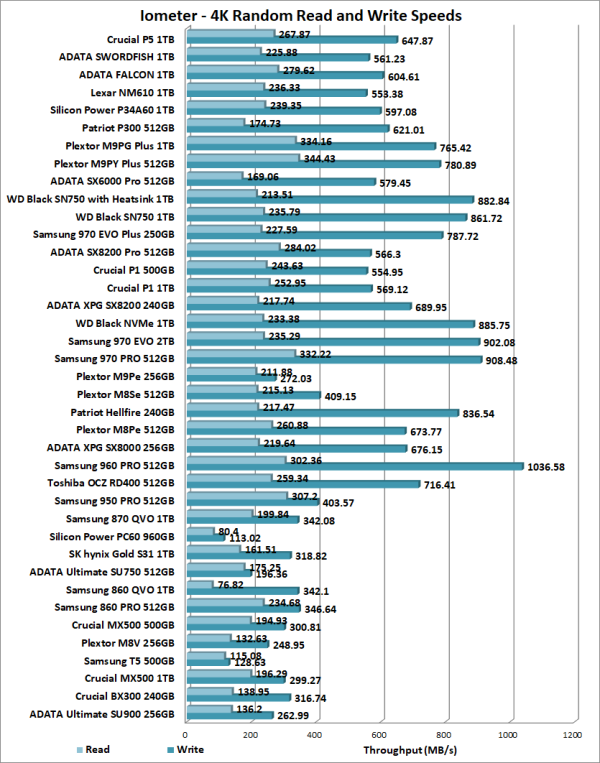
While not the fastest drive here, the P5 also performed fairly well when doing random reads and writes. In our tests, the drive was able to read at 267.87 MB/s and write at 647.87 MB/s.
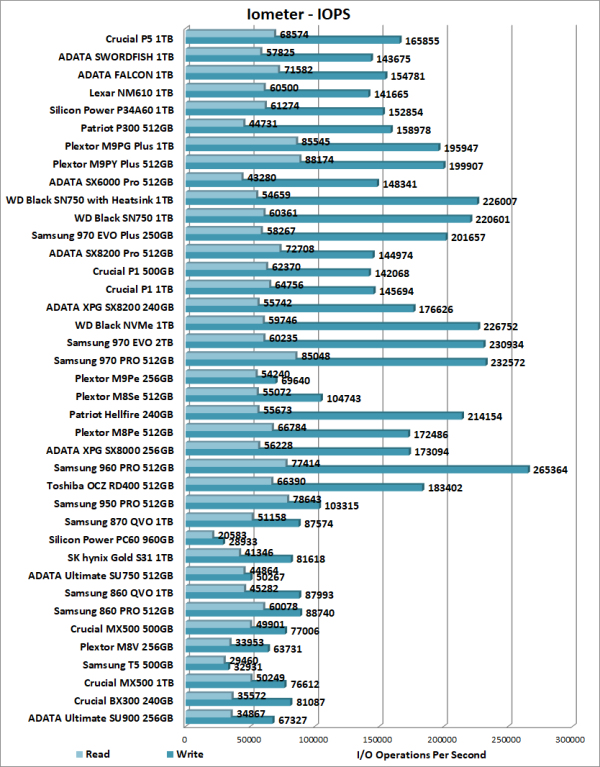
According to Crucial, the 1TB P5 is capable of 390,000 IOPS when reading and 500,000 IOPS when writing 4K blocks. In our tests, the drive reached 68,574 random read IOPS and 165,855 random write IOPS. As with most drives, the P5 performed better at higher queue depths. With four threads and the queue depth set to 32, it reached 414,927 random read IOPS and 406,740 random write IOPS.
PCMark 8 - Storage Test:
PCMark 8 is a complete benchmark for Windows. It includes five benchmark tests, each designed around a specific scenario. The storage benchmark measures drive performance using real-world traces recorded from Adobe Creative Suite, Microsoft Office and a selection of popular games.
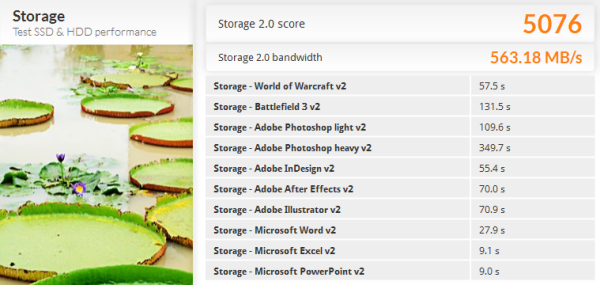
PCMark 8 also includes a consistency test which measures the performance consistency and degradation tendency of a storage system. The test reports the performance level at the start, the degraded steady-state and the recovered state as well as the number of iterations required to reach the degraded state and the recovered state. For this test, we are focusing on the Adobe Photoshop (Heavy) trace and will look at both the bandwidth and latency of the drive

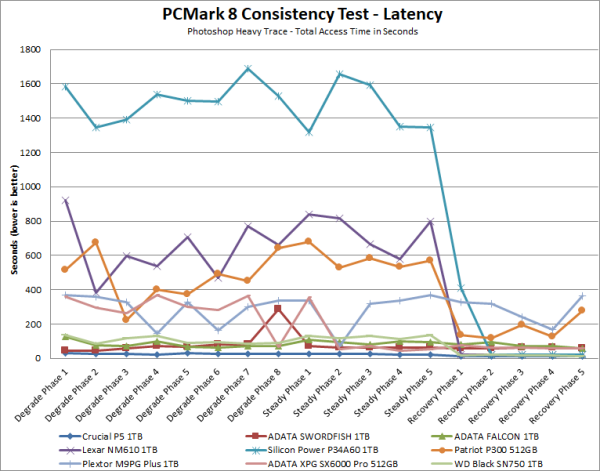
The P5 did quite well throughout PCMark's consistency test. While the average bandwidth dropped below 800 MB/s during the degradation and steady state phases, it was still considerably faster than most of the other PCIe SSDs that we've tested. More importantly, the P5 had no problems bouncing back during the recovery phase.
TRIM Performance:
While SSD's offer many benefits, there are some downsides to using flash memory. One of the biggest issues people run into is performance degradation. Over time, an SSD will run out of fresh blocks and will have to write over data the file system has marked as deleted. This procedure is very complicated and can slow an SSD's write speeds considerably.
To fix this problem, most manufacturers have added TRIM support to their SSDs. The TRIM command allows an operating system, such as Windows 10, to tell an SSD which data blocks are no longer in use. Using this information, the drive pro-actively erases these blocks and adds them to the free block pool.
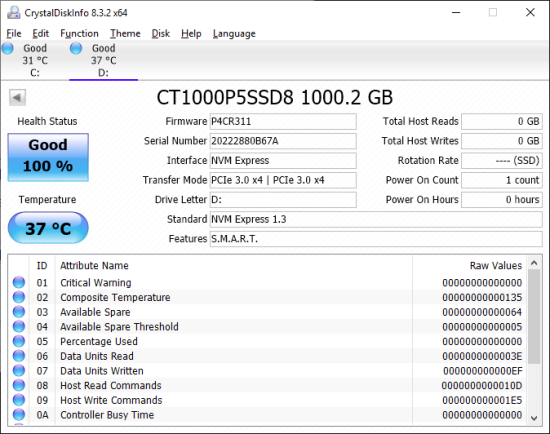
To test the P5's TRIM and garbage collection functions, I first put the drive in a "dirty" state. I used Iometer to fill 80% of the drive and then ran a random write test for 30 minutes. Looking at the screenshot below, you can see that the P5's average read and write speeds dropped to 1858.04 MB/s and 259.19 MB/s, respectively.
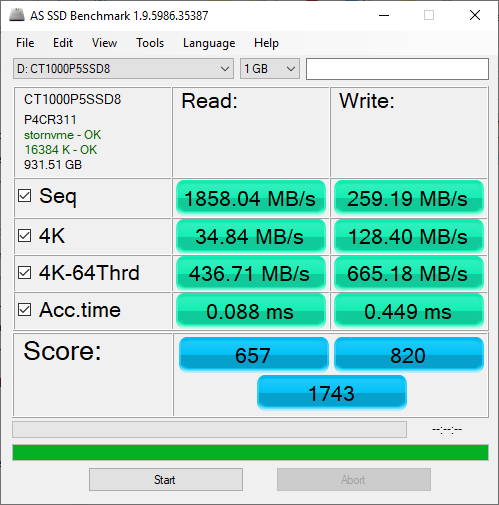
Crucial P5 - Dirty
To see how well the P5 could recover, I let the computer sit for about 30 minutes and then reran the test. The drive wasn't able to reach the factory fresh performance shown in our earlier tests. However, its sequential write speed jumped up to 1033.61 MB/s.
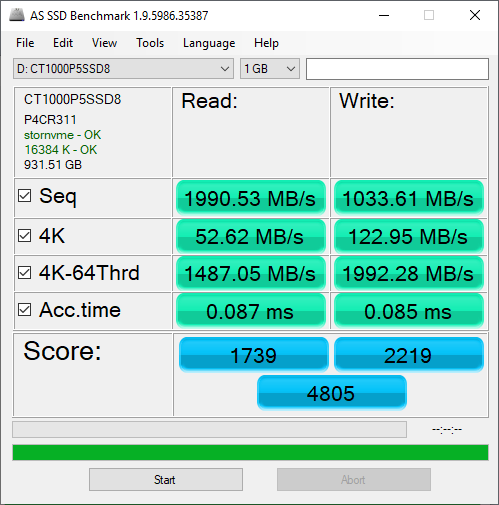
Crucial P5 - After TRIM
Lastly, I used Parted Magic to perform a secure erase on the P5. With the drive wiped clean, it had average read and write speeds of 2782.33 MB/s and 2513.49 MB/s, respectively.
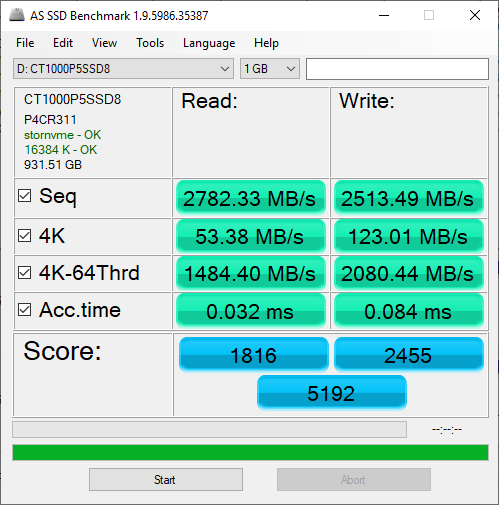
Crucial P5 - Secure Erased
Adaptive Thermal Protection:
While PCIe SSDs like the P5 offer impressive performance, they also generate a good amount of heat. To keep them from overheating, Crucial has implemented what they call Adaptive Thermal Protection. This technology monitors the temperature of a drive and will automatically reduce its performance when it reaches a certain point.
While not the hottest SSD we've looked at, the P5 can get get a bit toasty. At idle, temperatures hovered around 45 ºC. When pushed hard, the drive reached temperatures as high as 74 ºC when reading and 71 ºC when writing.
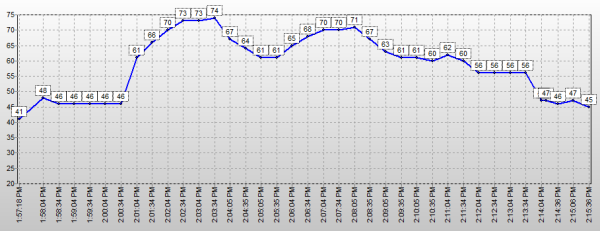
When the P5 reached these temperatures, its Adaptive Thermal Protection would kick in and throttle its performance. While this did happen a few times when reading, it was most apparent when writing. Looking at the screenshot below, you can see that after writing about 150GB of data, the drive's sequential write speed dropped to about 600 MB/s.
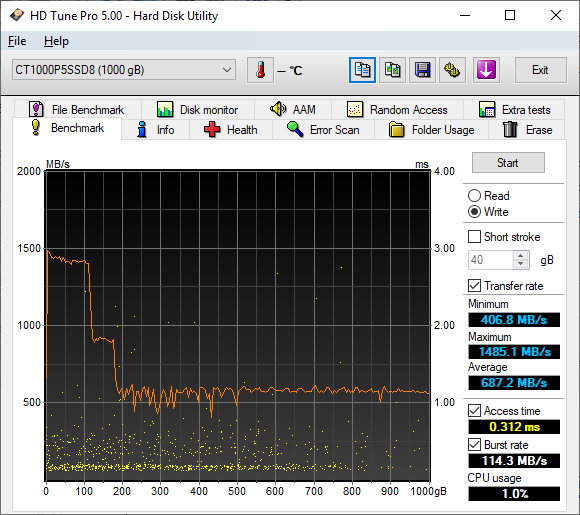
If you're going to push the P5 hard and don't want Adaptive Thermal Protection to activate, you may want to consider adding a cooling fan or attach a heatsink to the drive. With an 8cm fan blowing over the drive, there was a notable drop in temps. At idle, the drive's temperature dropped down to 36 ºC and rose to 53 ºC under heavy workloads. As a result, thermal throttling did not occur.
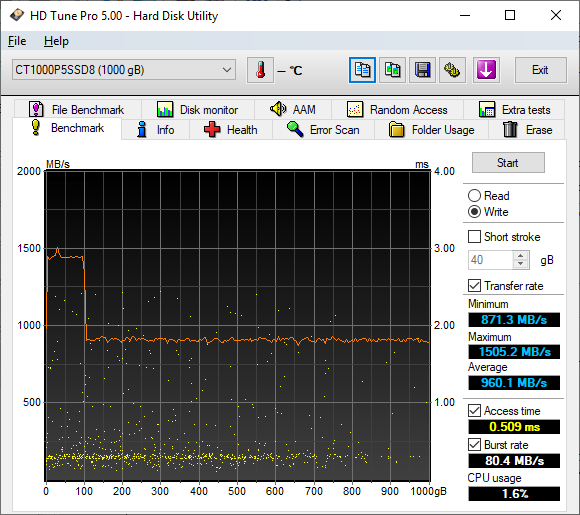
Final Thoughts:
Crucial has clearly put a lot of time and effort into their new P5 SSD. Instead of using an off the shelf solution from a company like Phison or Silicon Motion, this new drive has been engineered from the ground up. Everything from Micron's cutting-edge DM01B2 controller, with its innovative technologies, to the 3D TLC NAND flash has been developed in house. Combine all this with a PCIe Gen3 x4 NVMe 1.3 interface and you have drive that is capable of delivering the performance, reliability and features that gamers and creative professionals are looking for. The P5 flew through our sequential transfer rate tests, reading at speeds as high as 3,504 MB/s and writing at more than 3,252 MB/s. The drive's performance wasn't nearly as impressive when doing random writes. Nevertheless, it was able to produce more than 165,000 IOPS at low queue depths.
Of course, fast read and write speeds aren't the only things the P5 has to offer. In addition to a large DRAM cache, the drive uses technologies like Dynamic Write Acceleration to optimize performance as well as Multistep Data Integrity Algorithms and Redundant Array of Independent NAND (RAIN) to protect data and prevent it from becoming corrupted. The P5 also features thermal and power loss protection, active garbage collection, NVMe Autonomous Power State Transition (APST) support and full hardware-based encryption. To top it all off, it comes with Acronis True Image cloning software and is covered by a generous 5 year warranty.
The Crucial P5 is available now in 250GB, 500GB, 1TB and 2TB capacities. Prices on Amazon.com currently range from $55 up to $340, with the 1TB version reviewed here retailing for about $150.

Highs:
- Available in 250GB, 500GB, 1TB and 2TB capacities
- PCIe 3.0 x4 interface with NVMe protocol
- Micron DM01B2 controller
- Equipped with Micron 3D TLC NAND
- Excellent sequential read and write performance
- Good random read and write performance
- Small M.2 2280 form factor
- Large DRAM cache
- Dynamic Write Acceleration
- Supports Redundant Array of Independent NAND and Multistep Data Integrity Algorithms
- Full hardware-based encryption
- Supports TRIM and active garbage collection
- Thermal and power loss protection
- Includes Acronis True Image cloning software
- 5 year warranty
Lows:
- Write speed drops when SLC cache is full
- Gets hot under heavy workloads




